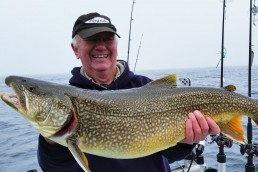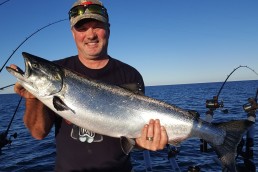Lake Trout: The Forgotten ‘Kings’ of Lake Michigan
SHARE THIS POST
The sky was turning a light grey as we rounded the corner out of the harbor and headed north to the “fishing grounds” for trophies. I could see several lights from some smaller boats dotting the shoreline ahead of us. My plan was to stay a ways outside of them and run 30 to 40 feet just off the ledge. I picked out several Rapalas to run and had a mixture of floaters and Husky Jerks to work the backside of my inline planer boards. Clown, Hot Steel, Bleeding Hot Olive and Vampire will start my lineup and a couple of my favorite Warrior spoons, Naked Natalee and Psyco Perch will start on the working sides of my Slide Divers. About a mile north of Algoma’s famous Lighthouse, I powered down and brought the Grand Illusion to trolling speed to look for the “kings.”
Trevor was on his second rod and was just clipping the Yellow Bird on when he yelled, “Fish, fish—here we go! That new Hot Steel-colored Rapala on the far Bird—I knew that’s going to be a killer!”
Killer was right. My nephew has developed a good eye for picking out hot baits.
He then grabbed the rod and passed it to the first one up. He then finished setting out his other Yellow Bird and rod and headed to get the net.
This was no small fish, and in this shallower, clearer water I was running 12-pound-test Trilene fluorocarbon leaders behind 30-pound Trilene braid on Abu Garcia Alphamar 16-line counter reels. I had the medium-light Ugly Stik GX2s bent right over, and “horsing” the fish was not an option.
I knew we’d just have to take our time on this one. And with light line and stickbaits, it was best to go easy on a fish as most hook-ups tend to be “lip and cheek” with the multiple hooks on the body baits and lighter line to get you more strikes.
But big fish demand a little patience in the heat of the moment.
“It’s a dandy Trevor!” I exclaimed. “Careful of the hooks when you net it! We don’t want to lose this one!”
Trevor slid the net under the golden lake trout to the cheers of everyone on board. It was a beautiful 24-pounder to start the day.
Are you enjoying this post?
You can be among the first to get the latest info on where to go, what to use and how to use it!
The sun still had yet to peak above the horizon, and the crimson-and-orange pre-dawn colors looked like a Rembrandt painting in the eastern sky as we continued to set the rest of the lines. We were eventually in shallower 25- to 35-foot water depths, and before we finished getting all our poles set, we boxed two nice football-shaped brown trout and another dandy lake trout.
Trophy lake trout have long been overlooked as the original “king” of Lake Michigan. Long before chinook “king” salmon were planted in Lake Michigan in the late ‘60s, the lake trout were the native sport fish that both regular and commercial fishermen sought for table fare. A long-lived fish, these trout can weigh up to 40 pounds. Decades ago, sport anglers targeted these lake trout with crude, homemade equipment and tackle. In the ‘70s, the appearance of the king salmon brought about an industry switch to upgraded equipment for the Great Lakes’ trolling anglers. In the early days I remember targeting and catching kings in the early morning, and by the time the morning bite had slowed, we had transitioned into lake-trout fishing and finished filling our coolers with the “spotted kitties” before heading back to port.
Sea lampreys, the unwanted exotic species, came to the Great Lakes via the ballast water from ocean-faring freighters. These all but wiped out the lake trout in the ‘50s, but many years of research and strategic planting of trout fry by the U.S. Fish and Wildlife have helped to grow the population and the trout are now naturally reproducing, leading to 40-pound trophies in these waters But with the ever-changing composition of the forage base, lakers still are one species that has adapted to foraging on the round goby, another exotic that has populated the system, giving lake trout ample forage to reach trophy proportions.
Recent data compiled by the U.S. Fish and Wildlife has shown that lake trout have been “successfully reproducing at a fairly good pace.” As a native species to the region’s waters, the USFW has diligently worked over the past 50 years to establish a native population of the self-sustaining trout. The recent data has also shown that the long-term efforts have paid off and this species is on its way to recovery with adjustments to the stocking numbers in the works. This could free up federal hatchery space to possibly allow the department to look into other species that could be revived and provide additional forage options for more trout and salmon in the future.
Could we see a future attempt to reintroduce herring to Lake Michigan? Only time will tell.
For the fishing outlook for 2017, in Wisconsin, an overall salmon and trout harvest of 384,908 fish last year—up 43 percent from the 269,978 taken in 2015—marked the highest catch since 2012, leading many to believe this year could see similar numbers. It came as little surprise that the waters off of Algoma and Kewaunee harbors were once again, and for the 21st straight year, the top fishing grounds for king salmon and for the 15th straight year top producers of steelhead. These waters also hold a fair amount baitfish all summer long, and where the bait goes so do the top predators.
A very mild winter for the second straight year has allowed shoreline trollers shots at early success for browns. Lake trout remained closed until March 1, and probably for the very last time. The WDNR is working on and expected to pass an emergency order to open the lake trout season year ‘round, except off the mid-lake reefs, and to increase the daily bag limit back up to five to match the rest of the trout and salmon in Lake Michigan. Data shows that the population can sustain almost double the current catch numbers without affecting the natural reproduction of the population.
With all that in mind, the outlook for 2017 is bright and I’m looking forward to a very early spring. The mild winter, ice-out in many harbors in mid-February, and the ice thickness itself this winter all point to the lake’s surface temperatures warming up early. I for one am expecting to see a great early trout season with browns and lakers available in good numbers followed by an early, mid-May appearance of king salmon and steelhead, at least in the Algoma area.
Tip of the Month
I’m often asked about lure selection and why. Clear-water conditions are more in Lake Michigan, and one would think that lure selection is more critical, and you’d be right. I’ve tried lots of different baits and my wife can attest to the large selection that I keep adding to. Since we’re talking about spring lake trout, one bait continually sticks out. Originally developed back in 1936, the Rapala Original Floating Minnow has stood the test of time and is still a “go-to” lure for me. Made of balsa, the Original “Floater” can be trolled or cast and swims with the legendary Rapala “wounded-minnow” wobble. Because it mimics the natural action of a baitfish, it attracts all kinds of species, and lake trout are no exception. When in shallow water and you’re using light line, it is sometimes necessary to slow way down or even coast to bring a larger fish to net. Floaters will slowly rise, sometimes triggering strikes, and most importantly, will keep you out of snags. Color selection is also a key. Rapala Custom High-Definition Color Patterns are some of the finest HD lure patterns on the market. Created in perfect detail, the Custom HD Finishes are lifelike replicas of nature below. So, tie on a Rapala and hold on as that trophy lake trout of a lifetime gives you an epic battle this spring.
MWO
SHARE THIS POST
Did you enjoy this post?
You can be among the first to get the latest info on where to go, what to use and how to use it!
Lee Haasch
Capt. Lee Haasch is a charter captain out of Algoma, Wis., with more than 45 years of Great Lakes angling and guiding experience. Haasch has been instructing anglers for over 30 years with education seminars and timely freelance articles.



